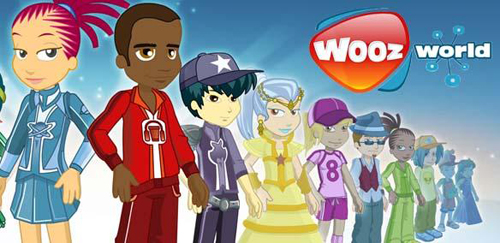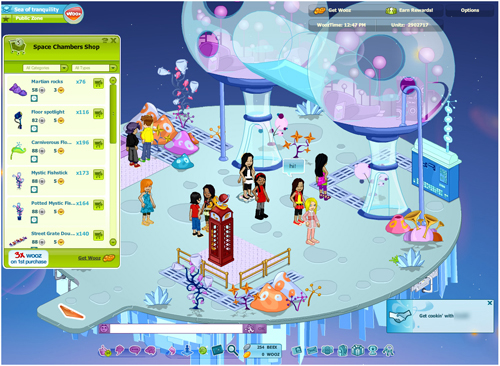锁定少儿用户,在线社交游戏Woozworld运营有创意
Woozworld是一款基于网页的社交游戏,主要用户是9到14岁的少儿群体,这个项目起源于Tribal Nova公司,该公司原来主要生产儿童科教游戏,其中有个基于网页技术的开发项目就是Woozworld的前身。因为这个项目锁定的是更年长一点的用户,所以就在2009年12月从Tribal Nova中独立出来,成立了一个新公司,也就是现在的Woozworld。
Woozworld公司CEO埃里克·布拉萨德(Eric Brassard)解释道,成立新公司的原因是想从原来开发“教育软件”转向“娱乐软件”,因为儿童的消费能力掌握在父母手中,你的市销营销对象只可能是家长。这些家长希望买一些教育产品给孩子,但孩子长大的时候,他们就不会想要“寓教于乐”的玩具,他们需要大孩子的游戏。
孩子们在Woozworld的游戏世界中,可以创建自己的虚拟形象(Woozen)、创建个人空间(Unitz),然后还可以买东西来点缀自己的Unitz,但这是一个循序渐进的过程,并不是像《模拟人生》(The Sims)这种可以迅速完工的游戏。玩家可以用Beex(靠游戏经验赢取的积分)和Wooz(付费购买的虚拟货币)换取这些装饰品,也可以邀请好友参观自己的Unitz,拜访人气最高的Unitz,参加多种角色扮演类的活动。
因为这种游戏针对的是低龄玩家,所以它的虚拟经济系统会有针对性地提供一些详细的指示。游戏中的所有商品都是在NPC(非玩家角色)商店中销售,而且都有一个默认价格。和其他的社交游戏不一样的是,玩家在游戏中拣不到任何东西,不能掠夺也不能收割,要什么东西只能到店里去买。而且一旦买了东西,就不能再退货,所以整个系统更像是一个道具商店而非游戏经济圈。也就是说,玩家可以在自己的地盘中设置贩卖机,并向其中填充商品,然后转手卖给他人。游戏邦发现,只要东西在商店中上架,系统就会显示它的默认价格,不过玩家可以根据自己的意愿调整价格。
所以在Woozworld的游戏世界中,“创造利润”并非主要的游戏目标,这一点与传统的MMORPG游戏更为接近。虽然这些道具经常在NPC商店中进进出出,但它们一旦在某个商店断货,用户就只能找其他玩家购买。玩家的主要活动就是经营商店、购物消费,游戏动力并非赢取更多黄金。
虚拟货币Wooz在游戏中发挥了很大的作用,多数道具需要同时使用Beex和Wooz来换取,而且根本不可能用Beex购买的东西兑换成Wooz,这就决定了购买Wooz才是体验游戏的最主要途径。
大多数孩子都没有信用卡,所以Woozworld的两个营收渠道就是:手机短信和家长。在欧洲的Woozworld玩家可以通过收费手机短信购买虚拟货币,费用将从手机话费中自动扣除。但在北美地区,Woozworld采用的是另一套解决方案——北美的家长经常使用信用卡在线消费,所以孩子让父母帮忙购买在线商品的现象也很普遍。Woozworld还推出了信用卡VIP服务,支持家长包月消费,让孩子每周都能获得一些Wooz零花钱。
除此之外,Woozworld还与欧洲游戏充值卡经销商进行了合作,所以玩家又多了一个游戏充值卡的付费选项。据游戏邦了解,该公司还在寻找其他的计费合作伙伴,开拓不同的用户市场。埃里克认为,少儿在线社交游戏拥有巨大的市场潜力,因为这一群体的玩家规模最为庞大,而且为游戏付费的意愿也最高,绝不像年长而斤斤计较的用户群体,总是为误点击“购买”按钮而争论不休。
Woozworld的另一个创造性在于,它绑定了Facebook和Facebook credits。埃里克表示,家长经常会购买或因在Facebook上玩游戏而赢得不少Facebook credits,Woozword可以将家长的Facebook credits转换成Woozworld中的游戏积分给孩子使用。
Woozworld独立的社交环境,也是这款游戏成功的关键因素。因为加拿大高度重视儿童网络活动的安全性,所以Woosworld坚守这一底线,致力为玩家提供可靠的在线游戏环境。该游戏使用过滤器、监视器、聊天记录监测等手段,最大限度地减少了污言秽语等不良信息;游戏还获知,该公司还与加拿大皇家骑警队和国际刑警组织展开合作,绝不让虐童者染指这片净土。
该游戏目前仅推出法语和英语版本,但在东南亚、印度、欧洲和美洲也同样很有市场,计划翻译成更多种语言,并针对不同市场进行本土化处理。不过该游戏仍然只是一个新产品,开发团队的规模也比较小,所以只能先盯紧当下的核心产品,每隔两三周都会推出新功能和道具,保持玩家的新鲜感,提高用户留存率和消费欲望。
他们会围绕游戏营收创建新功能和道具,一般来说,新功能的第一级用户是VIP服务对象,然后才会向所有玩家普及,最后会彻底消声匿迹。只有这样才能避免玩家对旧道具腻味,玩家永远都不知道下次再查看小店时又会淘到什么新鲜玩意儿,这样他们就会时常关注商店的新动向。实际上,因为这些新道具都是在NPC商店中限量发售,所以玩家很可能一进店门就发现来迟了,货架早已空空如也。这种情形在圣诞节前的表现尤为明显,当时孩子们都放假了,所以就迫不及待地回到家玩起Woozworld,并在游戏中相互赠送礼物。
埃里克还表示,除了未来的本地化处理,公司还打算推出该游戏的手机版本,但没有透露具体细节,仅称会考虑投放传统手机和智能手机平台(比如iPhone和Android),但并没有移植到掌机平台的计划。(本文为游戏邦/gamerboom.com编译,转载请注明来源:游戏邦)
A Visit to Woozworld
After writing my article on virtual economies in MMOs, I received a number of interesting emails; one of which was an invitation to meet with Eric Brassard, the CEO of Woozworld. Woozworld is a web-based social game designed for tweens (ages 9-14), which doesn’t fall into my typical coverage zone of more mature MMO games. Nevertheless, since I happened to be in Montreal over the Christmas holidays, I decided to drop by and see what it was all about. At the very least, I figured I ought to see what kind of in-game economy Woozworld supported.
Woozworld’s tale begins with Tribal Nova, a company that produces educational games for children. Part of the web-based technology developed at Tribal Nova was co-opted to produce the underlying basis for Woozworld. This project, which targeted an older audience, was spun off from Tribal Nova, launching as an independent company around December 2009.
CEO Eric Brassard explained one of the major shifts in going from Tribal Nova to Woozworld was shifting from producing “educational software” to producing “entertainment software.” You don’t market directly to children; you market to their parents. And parents want to buy educational stuff for their kids. However, once kids get older, they don’t want “educational” toys anymore; they want big kid games!
The basic idea of Woozworld is a combination sandbox and social game. Each user creates their avatar (Woozen) and can create a number of personal spaces (Unitz). Then they buy stuff to put in their Unitz, decorating them in a tile-based manner not unlike The Sims. The stuff is bought through the game’s two currency systems: Beex (a free currency obtained by playing the game) and Wooz (a premium currency purchased with real money). Players can invite friends over to their unitz, visit popular unitz, socialize, and engage in various role-play activities and games. Eric took me on a tour of the live game, showing me all sorts of different activities and games players had made up within the game world.
Given my background in virtual economies, I was particularly interested in that aspect of the game. Because the game is targeted at a younger audience, there is a good bit of hand-holding in the economic system. Everything in the game has a default price set by the game’s creators: this is the price at which the item is sold from NPC shops. There is no finding items in the game world: no looting or harvesting. And once purchased, you cannot sell something back to the NPC shop. Basically, it’s a lot more like an item shop than a game economy. That said; there are vending machines that players can place in their areas, then place items in the vending machine to sell to others. When an item is first entered in, the default price shows up; players can chose to change it if they wish.
As a result of these systems, “profit-making” is not really a primary activity in Woozworld, the same way it is in more traditional MMORPGs. Although items do come and go from the NPC stores – and certain items often go out of stock, requiring players who want that item to buy it from another player – the primary activities of the game are not generally based on a player-driven market. In fact, most of the stores Eric showed me were based on the role-play aspect of running and shopping at a store, rather than the meta-gaming desire to get more gold.
Besides, of the two currencies, the paid currency – Wooz – plays a very important role in the game. Rather than have some items only cost Beex and others old cost Wooz, most items Eric showed me cost a mix of both Beex and Wooz. And it’s nigh impossible to obtain anything for Beex alone and turn around and sell it for Wooz. This meant that buying Wooz was a major part of playing the game.
I wondered about how viable such an operation would be. Considering that most tweens probably don’t have credit cards, how are you going to monetize this operation? Turns out such an operation is very viable, thanks to two main strategies: SMS and parents. In Europe, where the game launched to a very strong start – Eric indicated that France was a particularly important test-best for launching new social games – one of the main ways of collecting payments from people is via premium messages sent to cell phones. This allows Woozworld players to buy packs of in-game currency and pay it on their cell phone bill. In North America, Eric describes a somewhat different situation. Here, parents make a lot more purchases online with their credit cards, so it seems quite common for tweens to ask their parents to buy things for them online. Woozworld also features a credit-card VIP subscription feature, allowing parents to buy a monthly subscription for their tweens which provides a weekly Wooz allowance.
Woozworld isn’t limited to just these two main avenues, however. A partnership with a European game card distributor has led to a growing segment of game card sales. Future partnerships are being examined for other markets. Eric describes Tweens as a very strong market target for online social games. Not only is that age group the largest in number of players, it’s also the largest in the percentage of players who are interested in spending money online. This in stark contrast to us older jaded folk who trudged through the trenches of shareware, piracy, and free-to-play; the penny pinchers who endlessly debate every last click of the “pay now” button!
Another big success for Woozworld has been integration with Facebook and Facebook credits. Eric describes how parents who use Facebook might end up with some extra Facebook credits; either through purchases or just by playing games there. By linking Facebook and Woozworld, parents with Facebook credits can convert them into points for their children to use in Woozworld. In a way, parents and their tweens can play together… albeit in their own separate social environments.
The separateness of the Woozworld social environment is very important for the success of the game. Abiding by the various online child protection acts in the countries in which it operates, Woozworld tries to provide a safe environment for its players. Vigorous use of filters, monitoring, and chat logging helps reduce incidences of swearing and verbal harassment. Closely working with the RCMP and Interpol has also kept the game free of child predators.
The game currently operates in only two languages: English and French. However, its success spans the world. Eric talked about large groups of Woozworld players in South East Asia and India as well as Europe and the Americas. Plans to translate the game into other languages, as well as localize it for special markets, are being looked into, but the game is still young and the team behind it still somewhat small. Right now they’re staying focused on their core product: with a 2-3 week development cycle, Woozworld produces new features and items regularly to keep their audience playing (and paying!).
This cycle is tied in to their payment methods too. Often, new items are introduced for VIPs only, then made available to everyone, then phased out entirely. This product cycle prevents players from becoming overwhealmed with legacy items in the stores, and creates a “shopping” experience where users aren’t sure what they’ll find in the stores when they go to check them out. In fact, because items are placed in NPC stores with limited quantities, it’s perfectly possible for players to show up and find nothing at all! Eric and I encounter that problem a few times when he was showing me the game. Of course, it was also the week before Christmas, so all the kids were out of school and playing Woozworld and possibly buying presents for each other.
In addition to further regional localization, Eric said that they have plans to produce a mobile version of the game. He couldn’t go into details about what platforms they would target or how much functionality would exist in the mobile game, but he did suggest that they would be looking into a number of handsets, both traditional cell phones and more powerful smartphones like the iPhone and Andoid. Conversely, there are no plans for a console port at this time.(source:gamasutra)









































 闽公网安备35020302001549号
闽公网安备35020302001549号